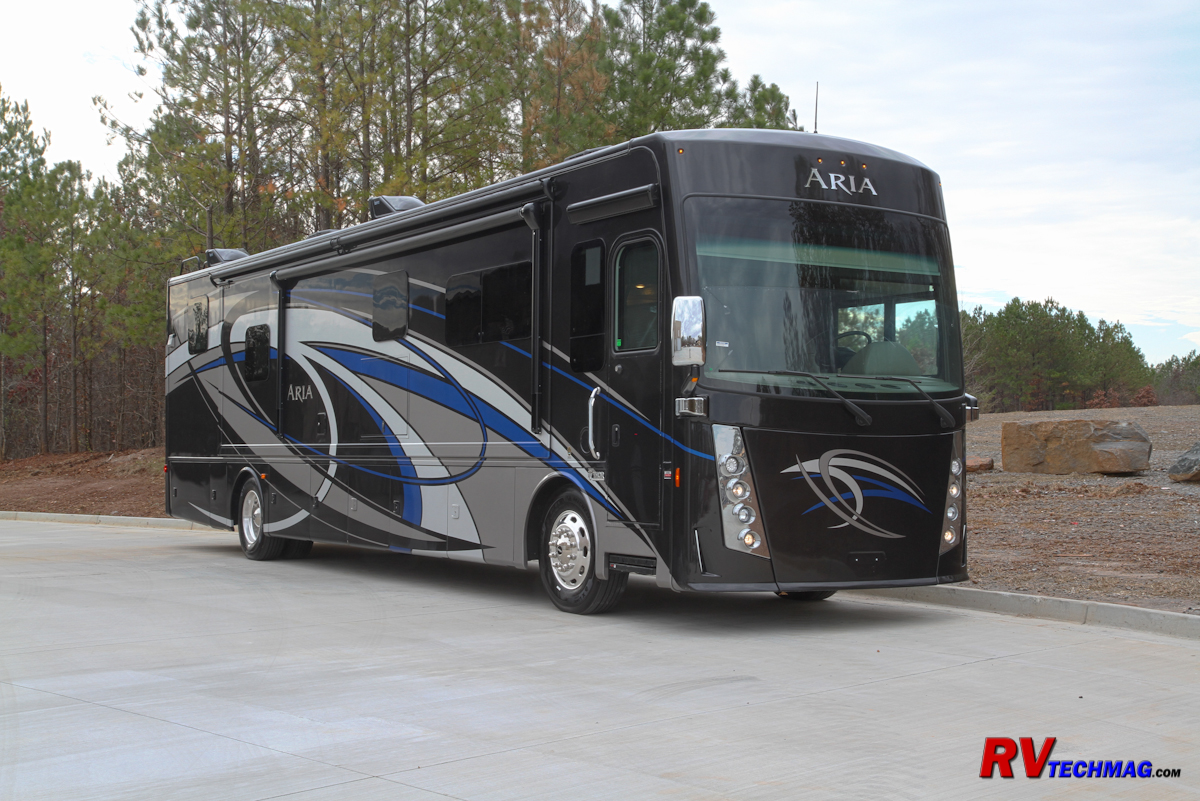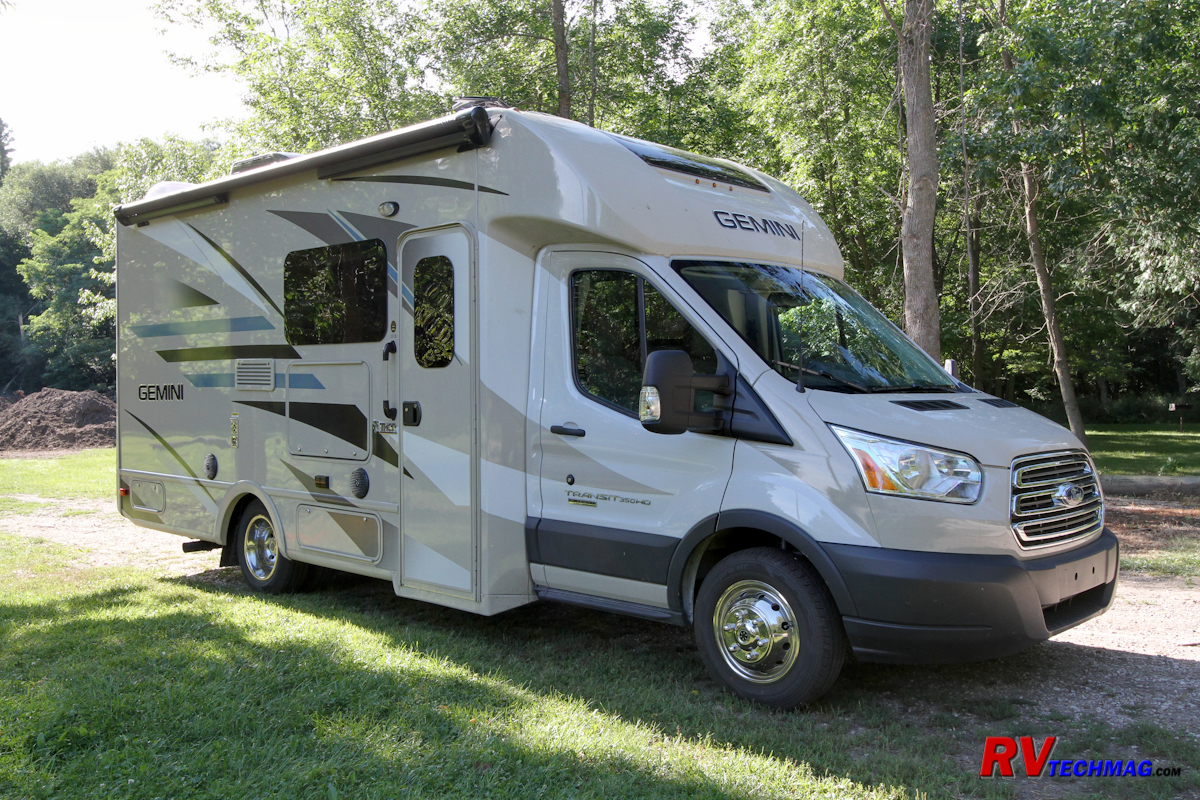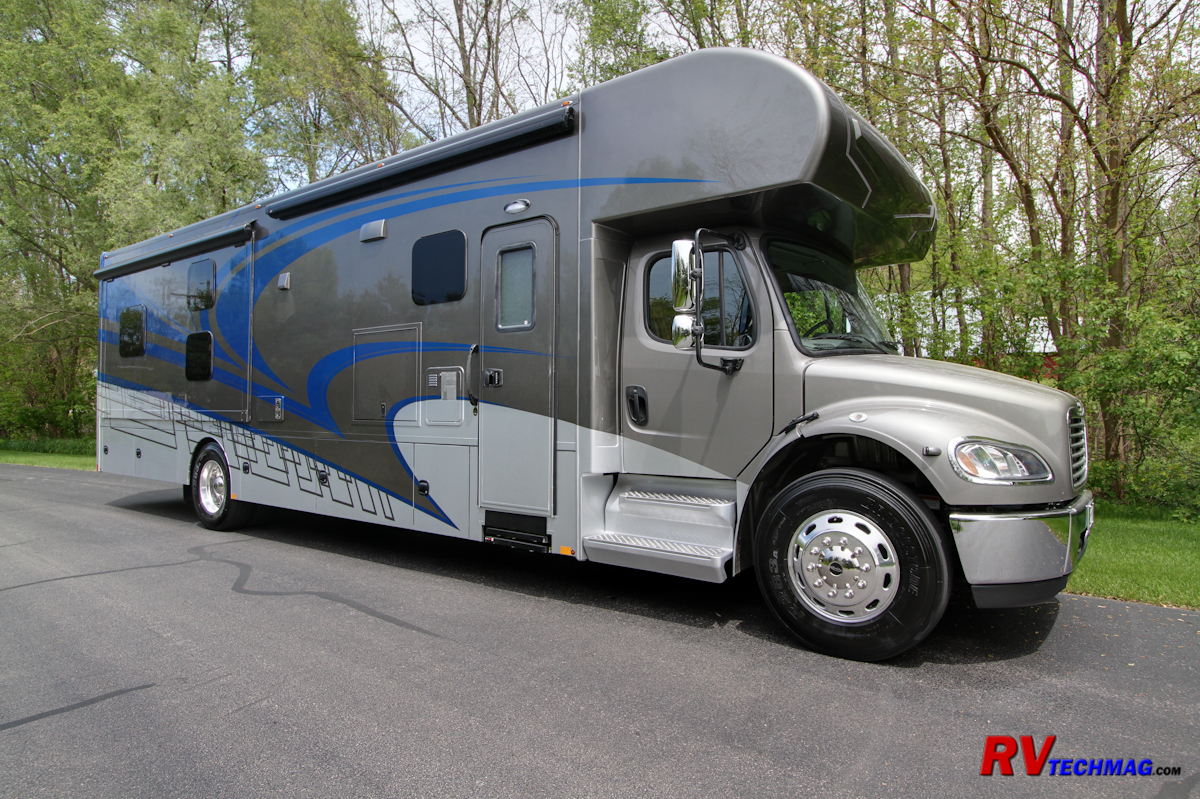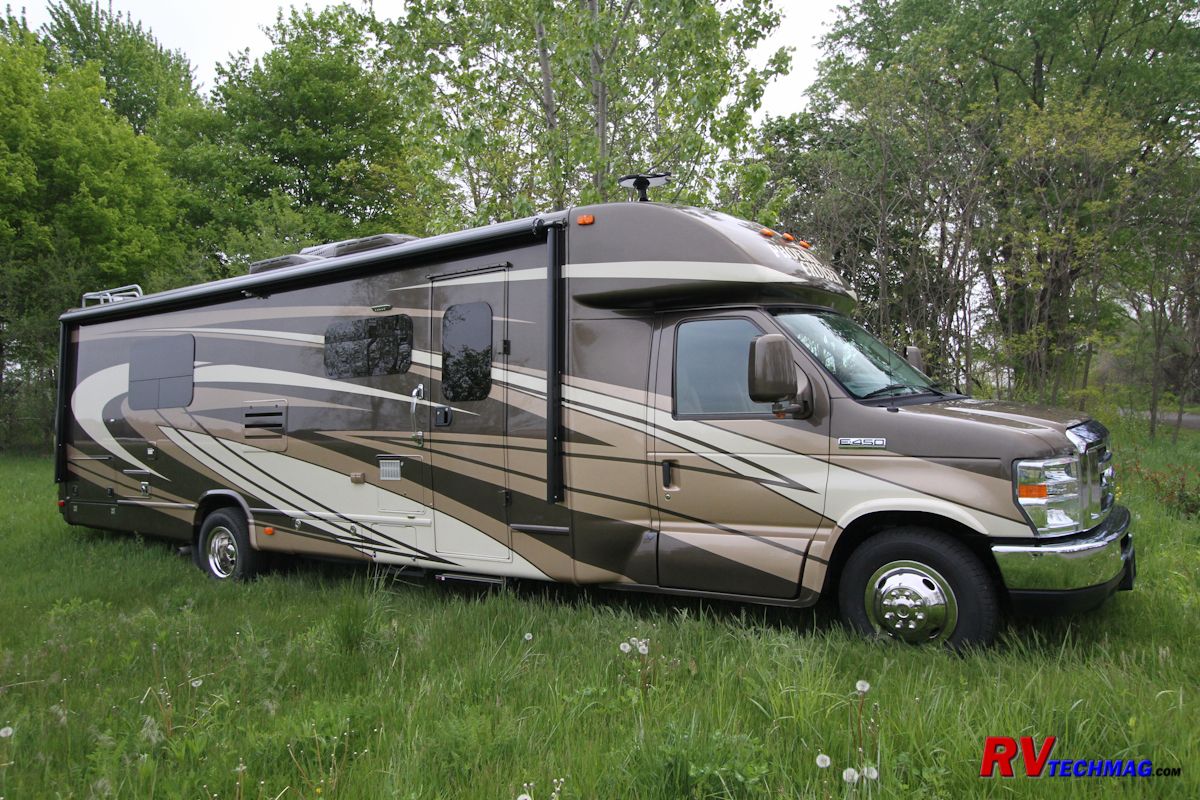Choosing a Motorhome
Selecting the best motorhome that meets your wants and needs
Article Date: November, 2017
Article and Photography by Mark Quasius

So, you've decided that you want to take the plunge and buy a motorhome. That's great! The RV lifestyle is one
of the best things you can do for yourself. It's proven that RV owners are generally more healthy than the general public and deal with
far less stress. You'll be able to travel and see the country at your own pace, sleep in your own bed and just pick up and move whenever
you feel the urge or don't like the weather or surroundings.
But not every motorhome is alike and it's important to select the particular motorhome that best suits your intended
style of travel. If you wind up with a motorhome that doesn't mesh with what you expect then it won't be an enjoyable experience and you won't
be very happy. Learning about the pros and cons of the various types of motorhomes will help you hit a bullseye when choosing your motorhome.
Unlike a sticks and bricks residence, a motorhome is a depreciable asset and will lose value as it ages. If you are looking
for a great financial investment, an RV is not for you. However, you can't take it with you and the investment of joy that it can bring you is
priceless. The memories you have of your travel will last forever and most buyers who take the plunge into motorhome travel wish they would have
started sooner in life.
Motorhome Classes
Motorhomes are categorized by classes, such as Class A, Class B, Class C, and a few variations of these classes. Class A
motorhomes are built on a commercial chassis and the RV manufacturer mounts the house structure on top of this chassis. Class A coaches have a bus
style look with a flat front end although actual bus conversions are technically not class A motorhomes. They are complete bus shells
that have been converted to motorhome use and are generally high end luxury coaches with the ultimate in amenities and stratospheric price tags. A
true Class A motorhome can be powered buy either gasoline or diesel engines and these engines can be located in the front of the chassis or the rear
of the chassis. Prices range widely from entry level to high end luxury coaches.
Class C motorhomes are built on a cutaway chassis, which uses a truck cab section and open frame rails behind for the RV
manufacturer to build their coach bodywork. This cab has the rear wall cutaway and blends into the main living area of the coach for access from
the cockpit area. Class C motorhomes have a cab-over section over the cab which increases space and are less expensive than a similarly equipped
Class A motorhome.
Class B motorhomes are the smallest and are basically passenger vans that have been converted into compact motorhomes. Most
of these units will have a raise roof for increased interior space. Class B coaches will generally have basic comforts such as a sink, water heater and
sleeping facilities. A recent trend has been toward B+ motorhomes, which can be identified by a cab-over section similar to a Class C motorhome.
Class A Diesel Pushers

Okay, lets start at the top of the list. A Class A diesel pusher is the ultimate Class A coach. The diesel engine is located in
the rear of the coach so is commonly referred to as a pusher. The diesel engine drives the rear axle via a transmission and very short drive shaft. Air
brakes do a better job of stopping a heavy vehicle than hydraulic brakes so the majority of diesel pushers will be equipped with air brakes although
some smaller entry level coaches may come with hydraulic brakes. Air-ride suspensions offer a smoother ride than leaf or coil springs and will be found
on all of the diesel pushers except for the most cost-conscious entry level units.
As the size of the coach goes up, so does the weight. Axles do have weight ratings that limit how much can be safely carried.
Longer and heavier coaches are often equipped with tag axles which is an axle that is located just aft of the rear drive axle. It doesn't provide any
propulsion because it's not connected to the driveline but it does provide additional weight carrying capacity. It also reduces the amount of rear
overhang behind the drive axle which makes for a more stable ride than a coach with a single rear axle. Lastly, it also adds a third set of brakes to the
coach, increasing its stopping power by approximately 50%. On coaches over 40' in length a tag axle is a mandatory feature.
A diesel engine produces more torque than a gasoline powered engine. Torque is what gets you up the hill and diesel engines produce
torque and horsepower at a much lower RPM than a gasoline powered engine. A gasoline engine will need to constantly downshift to increase its revs as it
climbs a hill or mountain grade. Coupled with the fact that gasoline engines are located up front by the driver while diesel pusher engines are located in
the rear of the coach a diesel pusher offers a much quieter ride.
Diesel pusher cooling systems can be of two different designs, either rear radiator or side radiator. Rear radiators aren't as
effective at cooling because they are located in a low pressure area of the coach when traveling so are typically quite large in size. They are generally
used on lower horsepower engines and block off access to the engine compartment from the rear of the coach. Dipsticks and coolant overflow reservoirs are
located within easy reach but any major service work, such as a fan belt change, will need to be done by removing access panels in the rear bedroom of
the coach to gain access to the engine. As the horsepower of the engine increases, so does it's need for improved cooling. For this reason the higher
horsepower coaches utilize a side radiator design which is more efficient. These radiators are located just to the side of the coach where there is better
airflow and will be physically smaller in size. This also allows easy access to the engine from the rear engine access cover, making service work much easier.
Diesel pushers can come with either solid I-beam front axles or independent front suspension (IFS). On a typical highway it's hard to
tell the difference between the two but once the road gets a bit bumpy the IFS will give you a smoother ride because each wheel is independently responding to
potholes and bumps wheras a solid axle tends to transmit these vibrations across the axle to both wheels. In addition, IFS gives you better control over the
vehicle in the event you experience a steer tire blowout and also minimizes the side to side rocking of the coach when entering a driveway approach at an angle.
IFS does add more complexity and cost to the chassis so you'll see more IFS on higher end coaches than entry level pushers.
Large diesel pusher coaches actually are not hard to drive. In fact, the high view allows the driver to better see what lies ahead
and anticipate lane changes in advance. While most first timers are wary about driving "such a big beast" they soon find out that their concerns were unfounded
and the coach was quite easy to drive. Obviously as the size increases, so does the need for parking space. You won't have a problem driving through a place such
as Yellowstone National Park in a Class A motorhome but don't expect to be able to find a place to park and watch the wildlife. For that you will need to tow a
smaller vehicle behind the motorhome, oftentimes referred to as a dinghy.
Class A Gasoline Powered Coaches

Class A motorhomes look much like their bigger diesel pusher brethren at first glance but there are notable differences. Gasoline
powered coaches generally are of a front engine design. with a long drive shaft connecting the engine and transmission to the rear axle. Front radiators
are also used so it's easy to identify a gasoline powered Class A by looking for a radiator grill at the front of the coach, which is not found on a
diesel pusher. Gasoline Class A motorhomes are very price sensitive so air-ride suspension and air brakes will not be found. They are also lighter than
diesel pushers so will be found in shorter lengths. Amenities are limited to keep them affordable but some of these units are very well equipped
indeed including toy hauler versions with a rear garage as shown in the image above. While the chassis of a gas Class A is quite different from a diesel
pusher, many of the attributes are the same. You'll still have the higher point of view, the need for a tow vehicle, and other attributes so much of what
applied to a diesel pusher will apply to a gasser.
Class C Motorhomes

Class C motorhomes are sometimes called mini-motorhomes and are easily identified by their cab-over structure. The cutaway chassis
plus a box offers a more affordable way to enter motorized RV travel. In the past, the cab-over's overhead bunk offered enough additional sleeping space that
many larger families chose a Class C coach over a Class A just for that reason. However, recent advances in Class A motorhome have resulted in the availability
of bunk bed floorplans as well as motorized beds that lower from the cockpit ceiling so the advantage that Class C motorhomes once had has since been eclipsed
by the latest Class A coaches designed for these families. However, a Class C still has a lower cost than a similarly appointed Class A so it remains a
popular entry level coach.
For many years the Class C coach market was dominated by the Ford E350 or E450 series van chassis, which is being phased out. Smaller
Class C coaches are now being built on the Ford Transit Van chassis or larger coachesd on the Ford F series chassis. One popular segment in smaller Class C
coaches is the Mercedes Sprinter chassis, which is equipped with a fuel efficient 3.0 liter diesel engine that delivers excellent fuel economy. Class C
motorhomes do have smaller holding and fresh water tanks than their Class A cousins, which is something to consider if you will be traveling or dry camping
without regular campground hookups.
Super C Motorhomes

Super C motorhomes are still Class C motorhomes but instead of a lighter van style chassis they are built on medium duty or even class 8
heavy duty truck chassis. This results in a diesel powered Class C coach with serious towing power, cargo capacity and basement storage. A Super C can offer
the ultimate driving experience compared to a forward control Class A due to the extended front axle but this also takes away some of the interior living space
compared to a Class A coach of the same length due to the extended hood and engine compartment. A Super C can make a great toy hauler because there is plenty
of room for the garage and plenty of power and towing capacity plus the higher ground clearance can allow the Super C to get into terrain that might damage a
Class A coach.
Class B and B+ Motorhomes
|

|

|
Class B motorhomes are the original van campers and feature a van with a raised roof. Their living space and amenities are limited but
they make great touring coaches because they can get into places and park where larger motorhomes can't fit. This market segment is growing quite rapidly in
recent years and a large percentage of these are the B+ motorhomes, which feature a cab-over section that can be used for sleeping, storage or as an
entertainment center. You won't get a full suite of amenities in a motorhome of this size but not everyone needs the extra room of a Class C or A motorhome and
just wants something to tour with. If your travel plans are based on two persons, you don't mind using campground showers and restrooms and want your motorhome
to be able to drive to your sightseeing destination without the hooking up and unhooking of a towed vehicle a Class B or B+ can be a great choice. B+ motorhomes
are commonly found on either Ford or Mercedes Sprinter chassis and can be an excellent bridge between a van camper and a Class C.
Slideouts
Slideouts are commonplace in the motorhome world and even offered on some Class B motorhomes. Slideouts offer additional room
when camping by extending the floor space. Slideouts do add to the vehicle weight so lighter motorhomes may only have one or two slides while the larger
Class A coaches may have four slides or even a large full-wall slide. Full-wall slides are different because they combine two adjacent slides into one large
slide. This opens up the entire area on one side of a coach, creating a more open look. This also creates some structural concerns because that is a large
open area in the sidewall and something has to hold the roof up. Typically larger headers are employed to provide adequate support for the roof but these
headers can cut down on the slideout height which may necessitate having smaller windows or eliminating overhead cabinetry. This varies from brand to brand
but it is something to consider when shopping the various motorhomes. Some manufacturers choose not to use full-wall slides but instead have created quad slide
floorplans that keep a small center portion between the two slides to support the roof while still giving that open look to the floorplan. Then again, you
should ask yourself if you really need to stand at the front of the coach and see all the way into the rear bathroom.
Floorplans
Anyone's number one criteria when selecting an RV is the floorplan. Not everyone has the same ideas and tastes so RV manufacturers
produce motorhomes with a number of different floorplans that appeal to different buyers. You'll be living in this RV so you want to make sure that the
motorhome that you choose is best suited for your needs. There are only so many feet in a motorhome and if you expand one area you take away from another so
there are always compromises. Take a look at the galley area. If the motorhome has a large lounge area with wide sofas and a large entertainment center the
odds are good that the galley has been made smaller to allow for that. That's fine if you prefer to dine out for your major meals but not so great if you
plan on doing a lot of cooking. Finding the floorplan best suited for you will undoubtedly be the most time consuming portion of your search for an RV.
When you shop for a motorhome at a dealer or RV show you will most likely see them on display with the slideouts extended and some
plastic fruit and photos added to give it more of a lived in look. That's fine if you want to see how the floorplan lays out when camping but doesn't show you
what the coach will be like when driving. When you find a coach that you are interested in be sure to view it with the slides retracted for travel. Some
coaches can have very narrow aisles that make it difficult for passengers to get to the bathroom when under way. Imagine yourself eating lunch at a rest area
in this situation. Also, loose furniture, such as ottomans, have to go someplace when the slides are retracted. If you have to stack them under the dinette
table you won't have room for your legs while seated there for lunch and if they sit on the sofa during travel your passengers won't be able to use it. Be sure
that you can still open cabinet drawers in the galley or bedroom when the slides are retracted as well. These are all factors that need to be considered prior
to the purchase rather than finding them out the hard way once you get home.
Motorhome Length
The common statement is to buy your last motorhome first. But this rarely happens because you never quite hit the target as to what you
need or want until you've had some experience with the various motorhome styles, floorplans and features. The most common misconception is to not want to buy a
motorhome longer than xx number of feet so that you can get into some of the older state and private RV parks. However, the campsites at these older parks
generally were built back in the day when coaches were shorter and didn't have slideouts. Since then, things have changed in the way RVs are made but the only
thing that changed at these campsites is that the trees and shrubs have grown up and filled out. Chances are good that the length of your motorhome won't be the
determining factor as to whether or not a campsite is suitable. It's the width that will determine that. 8' wide motorhomes are now commonly 8'-6" wide and have
slideouts that you won't be able to extend without hitting trees or brush that encroach on your campsite.
Maintenance
Any RV will require maintenance and motorized RVs also have a chassis and drive train to service and maintain. These costs can vary
depending on the type of motorhome as well as your ability to perform DIY service work. Gasoline powered motorhomes aren't that much different than a pickup
truck when it comes to your basic oil changes. If you are now doing this yourself the motorhome can also be another driveway project. If you have this done at
a service facility then you need to make sure that your coach fits into their service center. A small class C can be handled by most places but a 12' tall
Class A might be more challenging and will require service at a truck service center, which has higher labor rates.
Diesel powered motorhomes with air brakes take service requirement to a whole new level. The larger engines used in most diesel pushers
can require 28 quarts of heavy duty oil rated for diesel engines and some engines can hold as much as 50 quarts of oil. If you are handy and have a few 5 gallon
buckets and a place to dispose of the old drain oil you can still do this yourself but if not, you'll need to visit a service center familiar with working on
trucks or large motorhomes and those costs can add up fast. There are also more filters to deal with on a diesel pusher, which are larger and more expensive. The
air brake systems also need regular service of the air dryer so costs do add up. The good part is that diesel engine service intervals are based on time or
mileage, whichever happens first. The mileage interval of a diesel engine is higher than a gasoline engine so you can rack up more mileage on a diesel powered
coach than on a gasser before requiring service. However, the majority of motorhome owners don't put on that many miles so service becomes an annual thing based
on time rather than mileage. These are all things to consider but if you want to buy a larger motorhome you will want the power and improved fuel economy of a
diesel engine.
Summary
Choosing the best motorhome for you is an important step. Be sure to spend enough time researching the various models and brands. Give
the first impression time to wear off so that you aren't being overly influenced by the glitze and glamour of a staged product. Give serious consideration as
to how you intend to use the motorhome and spend time searching for one that best fits your criteria. Ther are lots of them out there so don't be locked into
whatever a dealer has in stock and wasnts to move. If you can't find what you want place an order for one that will have what you want. Also, take test drive
to find out how they handle. Some coaches tend to wander around a bit while others drive straight as an arrow. Do your due diligence up front and you'll have
many happy miles of enjoyable travel.
Return to Home Page
If you enjoyed this article be sure to recommend RVtechMag.com to your friends, like us on Facebook or Twitter
or subscribe to our RSS feed.



|











